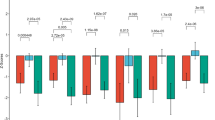Abstract
The Geschwind-Behan-Galaburda hypothesis of cerebral lateralization postulates an association between immune disorders and learning disabilities. So far, the empirical evidence for such a relationship has been ambiguous. The present study is an attempt to investigate the hypothesis in a population where all the individuals were affected by immune disorders. Thus, 29 students in a special school for asthmatic children (total number of students in the school: 32) were investigated. A number of reading tests with special focus on word decoding were administered. The parents filled in a detailed questionnaire on the prevalence of reading difficulties and immune disorders among the other family members. The proportion of students with reading problems — especially phonological problems — was much higher than would be expected in a normal population. Among the family members we also found an elevated incidence of both reading problems and immune disorders. A cautious interpreptation of these findings leads to tentative and partial support of the Geschwind-Behan-Galaburda hypothesis.
Similar content being viewed by others
References
Adamsl, M. J. (1990).Beginning to Read: Thinking and Learning about Print. Cambridge, MA/London: MIT Press.
Behan, W. M. H., Behan, P. O. & Geschwind, N. (1985). Anti-Ro antibody in mothers of dyslexic children,Developmental Medicine and Child Neurology 27: 538–542.
Bishop, D. V. M. (1990).Handedness and developmental disorder. Oxford: Blackwell.
Cohen, M., Hynd, G. & Hugdahl, K. (1992). Dichotic listening performance in subtypes of developmental dyslexia and a left temporal lobe brain tumor contrast group,Brain and Language 42: 187–202.
Ellis, N. (1989): Reading development, dyslexia and phonological skills,The Irish Journal of Psychology 10: 551–567.
Geschwind, N. & Behan, P. (1982). Left-handedness: Association with immune disease, migraine, and developmental learning disorder,Proceedings of the National Academy of Sciences 79: 5097–5100.
Geschwind, N. & Behan, P. (1984). Laterality, hormones and immunity. In: N. Geschwind & A. Galaburda (eds.),Cerebral Dominance: The Biological Foundations (pp. 211–224). Cambridge, MA: Harvard University Press.
Geschwind, N. & Galaburda, A., eds. (1984).Cerebral Dominance: The Biological Foundations. Cambridge, MA: Harvard University Press.
Geschwind, N. & Galaburda, A. (1987).Cerebral Lateralization. Cambridge MA: MIT Press.
Høien, T. & Lundberg, I. (1989). A strategy for assessing problems in word recognition among dyslexics,Scandinavian Journal of Educational Research 33: 3.
Larsen, J. P., Høien, T., Lundberg, I. & Ødegaard, H. (1990). MRI-evaluation of the size and symmetry of the planum temporale in adolescents with developmental dyslexia,Brain and Language 39: 289–301.
Oldfield, R. C. (1971). The assessment and analysis of handedness: The Edinburgh inventory,Neuropsychologia 9: 97–113.
Pennington, B. F., Smith, S. D., Kimberling, W. J., Green, P. A. & Haith, M. M. (1987). Left-handedness and immune disorders in familial dyslexics,Archives of Neurology 44: 634–639.
Rack, J. P., Snowling, M. J., Olson, R. (1992). The nonword reading deficit in developmental dyslexia: A review,Reading Research Quarterly 27(1): 29–53.
Stanovich, K. E. (1988). Explaining the differences between the dyslexic and garden-variety poor reader: The phonological-core variable-difference model,Journal of Learning Disabilities 21: 590–604.
Tønnessen, F. E., Løkken, A., Høien, T. & Lundberg, I. (1993). Dyslexia, left-handedness, and immune disorders,Archives of Neurology 50: 411–416.
Author information
Authors and Affiliations
Rights and permissions
About this article
Cite this article
Tønnessen, F.E., Høien, T., Lundberg, I. et al. Immune disorders and dyslexia. Read Writ 6, 151–160 (1994). https://doi.org/10.1007/BF01026910
Issue Date:
DOI: https://doi.org/10.1007/BF01026910




